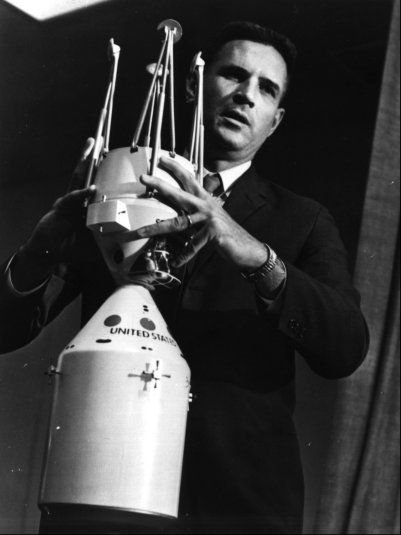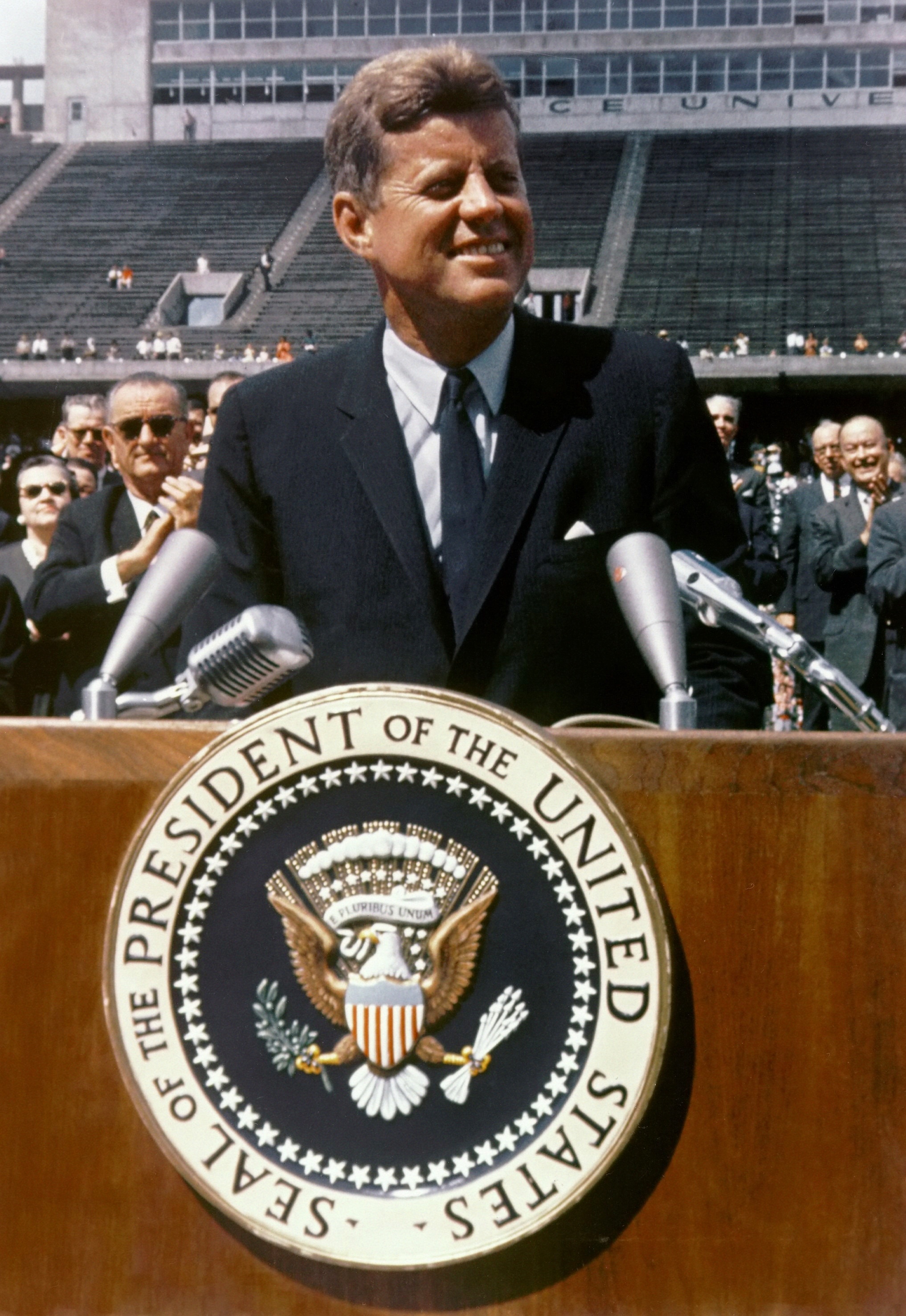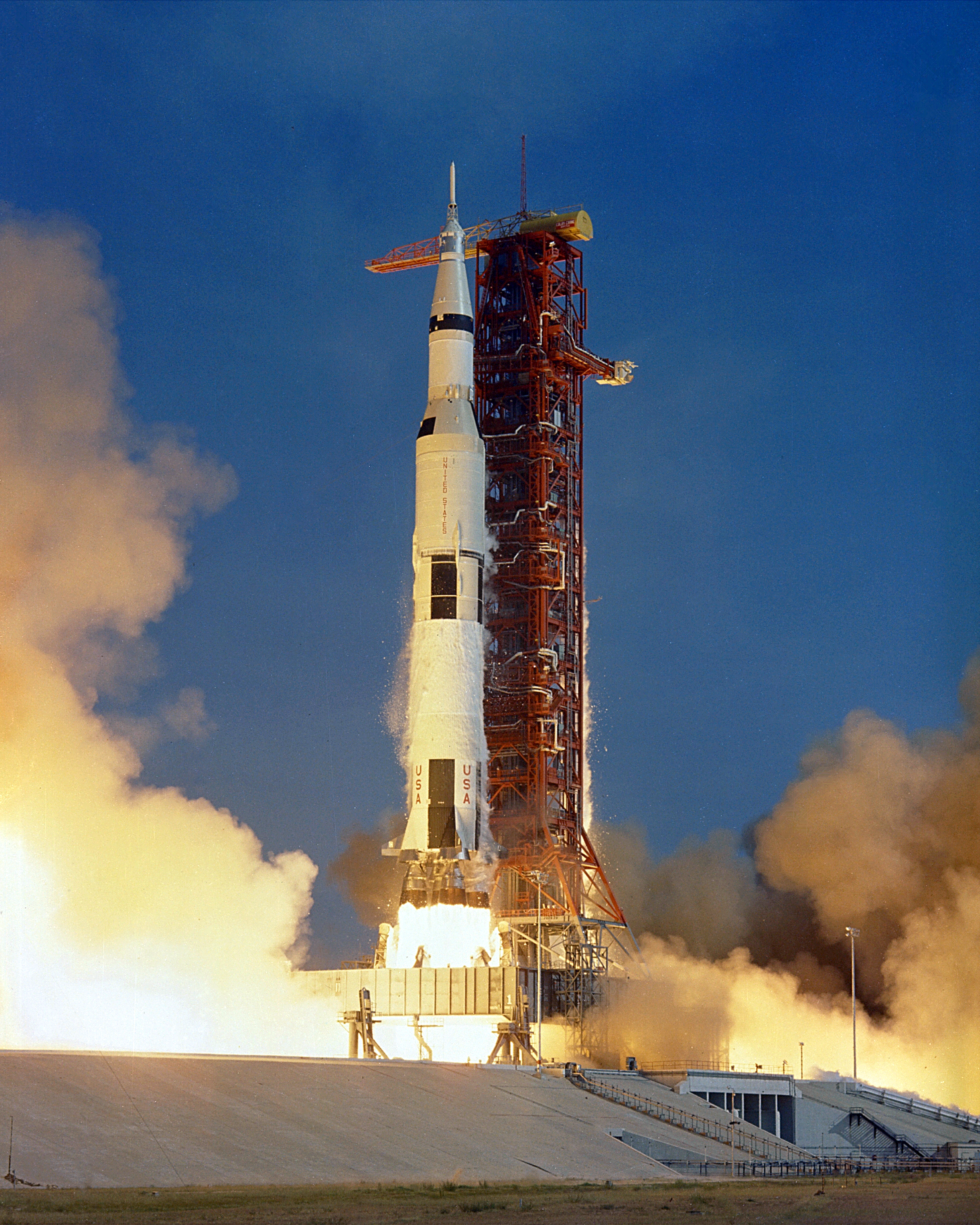|
Lunar Module
The Apollo Lunar Module (LM ), originally designated the Lunar Excursion Module (LEM), was the lunar lander spacecraft that was flown between lunar orbit and the Moon's surface during the United States' Apollo program. It was the first crewed spacecraft to operate exclusively in the airless vacuum of space, and remains the only crewed vehicle to land anywhere beyond Earth. Structurally and aerodynamically incapable of flight through Earth's atmosphere, the two-stage Lunar Module was ferried to lunar orbit attached to the Apollo command and service module (CSM), about twice its mass. Its crew of two flew the Lunar Module from lunar orbit to the Moon's surface. During takeoff, the spent descent stage was used as a launch pad for the ascent stage which then flew back to the command module, after which it was also discarded. Overseen by Grumman, the LM's development was plagued with problems that delayed its first uncrewed flight by about ten months and its first crewed flight by ... [...More Info...] [...Related Items...] OR: [Wikipedia] [Google] [Baidu] |
Apollo 14
Apollo 14 (January 31February 9, 1971) was the eighth crewed mission in the United States Apollo program, the third to Moon landing, land on the Moon, and the first to land in the Geology of the Moon#Highlands, lunar highlands. It was the last of the "List of Apollo missions#Alphabetical mission types, H missions", landings at specific sites of scientific interest on the Moon for two-day stays with two lunar extravehicular activities (EVAs or moonwalks). The mission was originally scheduled for 1970, but was postponed because of the investigation following the failure of Apollo 13 to reach the Moon's surface, and the need for modifications to the spacecraft as a result. Commander Alan Shepard, Command Module Pilot Stuart Roosa, and Lunar Module Pilot Edgar Mitchell launched on their nine-day mission on Sunday, January 31, 1971, at 4:03:02 p.m. Eastern Time Zone, EST. En route to the lunar landing, the crew overcame malfunctions that might have resulted in a second consecu ... [...More Info...] [...Related Items...] OR: [Wikipedia] [Google] [Baidu] |
Lunar Orbit
In astronomy and spaceflight, a lunar orbit (also known as a selenocentric orbit) is an orbit by an object around Earth's Moon. In general these orbits are not circular. When farthest from the Moon (at apoapsis) a spacecraft is said to be at apolune, apocynthion, or aposelene. When closest to the Moon (at periapsis) it is said to be at perilune, pericynthion, or periselene. These derive from names or epithets of the moon goddess. Lunar orbit insertion (LOI) is an orbit insertion maneuver used to achieve lunar orbit. Low lunar orbit (LLO) is an orbit below altitude. These have a period of about 2 hours. They are of particular interest in the exploration of the Moon, but suffer from gravitational perturbations that make most unstable, and leave only a few orbital trajectories possible for indefinite '' frozen orbits''. These would be useful for long-term stays in LLO. Perturbation effects and low orbits Most lunar low orbits below 100 km (60 mi) are unstable. Gravitationa ... [...More Info...] [...Related Items...] OR: [Wikipedia] [Google] [Baidu] |
Heliocentric Orbit
A heliocentric orbit (also called circumsolar orbit) is an orbit around the barycenter of the Solar System, which is usually located within or very near the surface of the Sun. All planets, comets, and asteroids in the Solar System, and the Sun itself are in such orbits, as are many artificial probes and pieces of debris. The moons of planets in the Solar System, by contrast, are not in heliocentric orbits, as they orbit their respective planet (although the Moon has a convex orbit around the Sun). The barycenter of the Solar System, while always very near the Sun, moves through space as time passes, depending on where other large bodies in the Solar System, such as Jupiter and other large gas planets, are located at that time. A similar phenomenon allows the detection of exoplanets by way of the radial-velocity method. The ''helio-'' prefix is derived from the Greek word "ἥλιος", meaning "Sun", and also Helios, the personification of the Sun in Greek mythology. ... [...More Info...] [...Related Items...] OR: [Wikipedia] [Google] [Baidu] |
Apollo 13
Apollo 13 (April 1117, 1970) was the seventh crewed mission in the Apollo program, Apollo space program and would have been the third Moon landing. The craft was launched from Kennedy Space Center on April 11, 1970, but the landing was aborted after an oxygen tank in the Apollo command and service module#Service module (SM), service module (SM) exploded two days into the mission, disabling its electrical and life-support system. The crew, supported by backup systems on the Apollo Lunar Module, lunar module (LM), instead looped around the Moon in a circumlunar trajectory and returned safely to Earth on April 17. The mission was commanded by Jim Lovell, with Jack Swigert as Apollo command and service module#Command module (CM), command module (CM) pilot and Fred Haise as Apollo Lunar Module, Lunar Module (LM) pilot. Swigert was a late replacement for Ken Mattingly, who was grounded after exposure to rubella. A routine stir of an oxygen tank ignited damaged wire insulation insid ... [...More Info...] [...Related Items...] OR: [Wikipedia] [Google] [Baidu] |
Apollo 11
Apollo 11 was a spaceflight conducted from July 16 to 24, 1969, by the United States and launched by NASA. It marked the first time that humans Moon landing, landed on the Moon. Commander Neil Armstrong and Lunar Module pilot Buzz Aldrin landed the Lunar Module Eagle, Lunar Module ''Eagle'' on July 20, 1969, at 20:17 Coordinated Universal Time, UTC, and Armstrong became the first person to step onto the Moon's surface six hours and 39 minutes later, on July 21 at 02:56 UTC. Aldrin joined him 19 minutes later, and they spent about two and a quarter hours together exploring the site they had named Tranquility Base upon landing. Armstrong and Aldrin collected of lunar material to bring back to Earth as pilot Michael Collins (astronaut), Michael Collins flew the Command Module Columbia, Command Module ''Columbia'' in lunar orbit, and were on the Moon's surface for 21 hours, 36 minutes, before lifting off to rejoin ''Columbia''. Apollo 11 was launched by a Saturn V rocket from ... [...More Info...] [...Related Items...] OR: [Wikipedia] [Google] [Baidu] |
Apollo 10
Apollo 10 (May 18–26, 1969) was the fourth human spaceflight in the United States' Apollo program and the second to orbit the Moon. NASA, the mission's operator, described it as a "dress rehearsal" for the first Moon landing (Apollo 11, two months later). It was designated an List of Apollo missions#Alphabetical mission types, "F"mission, intended to test all spacecraft components and procedures short of actual descent and landing. After the spacecraft reached lunar orbit, astronaut John Young (astronaut), John Young remained in the Apollo Command and Service Module, Command and Service Module (CSM) while astronauts Thomas P. Stafford, Thomas Stafford and Gene Cernan flew the Apollo Lunar Module (LM) to within (7.8 nautical miles; ) of the lunar surface, the point at which powered descent for landing would begin on a landing mission. After four orbits they rejoined Young in the CSM and, after the CSM completed its 31st orbit of the Moon, they returned safely to Earth. ... [...More Info...] [...Related Items...] OR: [Wikipedia] [Google] [Baidu] |
Apollo 9
Apollo 9 (March 3–13, 1969) was the third human spaceflight in NASA's Apollo program, which successfully tested systems and procedures critical to landing on the Moon. The three-man crew consisted of Commander James McDivitt, Command Module Pilot David Scott, and Lunar Module Pilot Rusty Schweickart. Flown in low Earth orbit, it was the second crewed Apollo mission that the United States launched via a Saturn V rocket, and was the first flight of the full Apollo spacecraft: the command and service module (CSM) with the Lunar Module (LM). The mission was flown to qualify the LM for lunar orbit operations in preparation for the first Moon landing by demonstrating its descent and ascent propulsion systems, showing that its crew could fly it independently, then rendezvous and dock with the CSM again, as would be required for the first crewed lunar landing. Other objectives of the flight included firing the LM descent engine to propel the spacecraft stack as a backup ... [...More Info...] [...Related Items...] OR: [Wikipedia] [Google] [Baidu] |
Apollo 5
Apollo 5 (launched January 22, 1968), also known as AS-204, was the uncrewed first flight of the Apollo Lunar Module (LM) that would later carry astronauts to the surface of the Moon. The Saturn IB rocket bearing the LM lifted off from Cape Kennedy on January 22, 1968. The mission was successful, though due to programming problems an alternate mission to that originally planned was executed. Like Apollo 4, this flight was long delayed, due in part to setbacks in development of the LM, manufactured by Grumman Aircraft. The original Saturn IB rocket that was to take the first LM (LM-1) to space was taken down during the delays and replaced with the one that would have launched Apollo 1 if the spacecraft fire that killed three astronauts had not occurred. LM-1 arrived at the Kennedy Space Center in June 1967; the following months were occupied in testing and placing the LM atop the Saturn IB. After final delays due to equipment trouble, the countdown began on Janua ... [...More Info...] [...Related Items...] OR: [Wikipedia] [Google] [Baidu] |
Low Earth Orbit
A low Earth orbit (LEO) is an geocentric orbit, orbit around Earth with a orbital period, period of 128 minutes or less (making at least 11.25 orbits per day) and an orbital eccentricity, eccentricity less than 0.25. Most of the artificial objects in outer space are in LEO, peaking in number at an altitude around , while the farthest in LEO, before medium Earth orbit (MEO), have an altitude of 2,000 km, about one-third of the Earth radius, radius of Earth and near the beginning of the Van Allen radiation belt#Inner belt, inner Van Allen radiation belt. The term ''LEO region'' is used for the area of space below an altitude of (about one-third of Earth's radius). Objects in orbits that pass through this zone, even if they have an apogee further out or are sub-orbital spaceflight, sub-orbital, are carefully tracked since they present a collision risk to the many LEO satellites. No human spaceflights other than the lunar missions of the Apollo program (1968-1972) have gone beyond L ... [...More Info...] [...Related Items...] OR: [Wikipedia] [Google] [Baidu] |
National Aeronautics And Space Administration
The National Aeronautics and Space Administration (NASA ) is an independent agency of the US federal government responsible for the United States's civil space program, aeronautics research and space research. Established in 1958, it succeeded the National Advisory Committee for Aeronautics (NACA) to give the American space development effort a distinct civilian orientation, emphasizing peaceful applications in space science. It has since led most of America's space exploration programs, including Project Mercury, Project Gemini, the 1968–1972 Apollo program missions, the Skylab space station, and the Space Shuttle. Currently, NASA supports the International Space Station (ISS) along with the Commercial Crew Program and oversees the development of the Orion spacecraft and the Space Launch System for the lunar Artemis program. NASA's science division is focused on better understanding Earth through the Earth Observing System; advancing heliophysics through the effor ... [...More Info...] [...Related Items...] OR: [Wikipedia] [Google] [Baidu] |
Space Vehicle
A space vehicle is the combination of a spacecraft and its launch vehicle which carries it into space. The earliest space vehicles were expendable launch systems, using a single or multistage rocket to carry a relatively small spacecraft in proportion to the total vehicle size and mass. An early exception to this, the Space Shuttle, consisted of a reusable orbital vehicle carrying crew and payload, supported by an expendable external propellant tank and two reusable solid-fuel booster rockets. Reusable launch systems are currently being developed by private industry. Early spacecraft or space vehicles were sometimes known as " spaceships", a term which comes from science fiction to designate a hypothetical vehicle which travels beyond low Earth orbit and is 100% reusable, needing only to be refueled like an airplane. History In the 1865 Jules Verne novel ''From the Earth to the Moon'', successful attempts are made to launch three people in a projectile with the goal of ... [...More Info...] [...Related Items...] OR: [Wikipedia] [Google] [Baidu] |
Lunar Orbit Rendezvous
Lunar orbit rendezvous (LOR) is a process for landing humans on the Moon and returning them to Earth. It was utilized for the Apollo program missions in the 1960s and 1970s. In a LOR mission, a main spacecraft and a lunar lander travel to lunar orbit. The lunar lander then independently descends to the surface of the Moon, while the main spacecraft remains in lunar orbit. After completion of the mission there, the lander returns to lunar orbit to space rendezvous, rendezvous and re-docking and berthing of spacecraft, dock with the main spacecraft, then is discarded after transfer of crew and payload. Only the main spacecraft returns to Earth. Lunar orbit rendezvous was first proposed in 1919 by Russian engineer Yuri Kondratyuk, as the most economical way of sending a human on a round-trip journey to the Moon. The most famous example involved Project Apollo's command and service module (CSM) and lunar module (LM), where they were both sent to a translunar flight in a single rocket ... [...More Info...] [...Related Items...] OR: [Wikipedia] [Google] [Baidu] |









